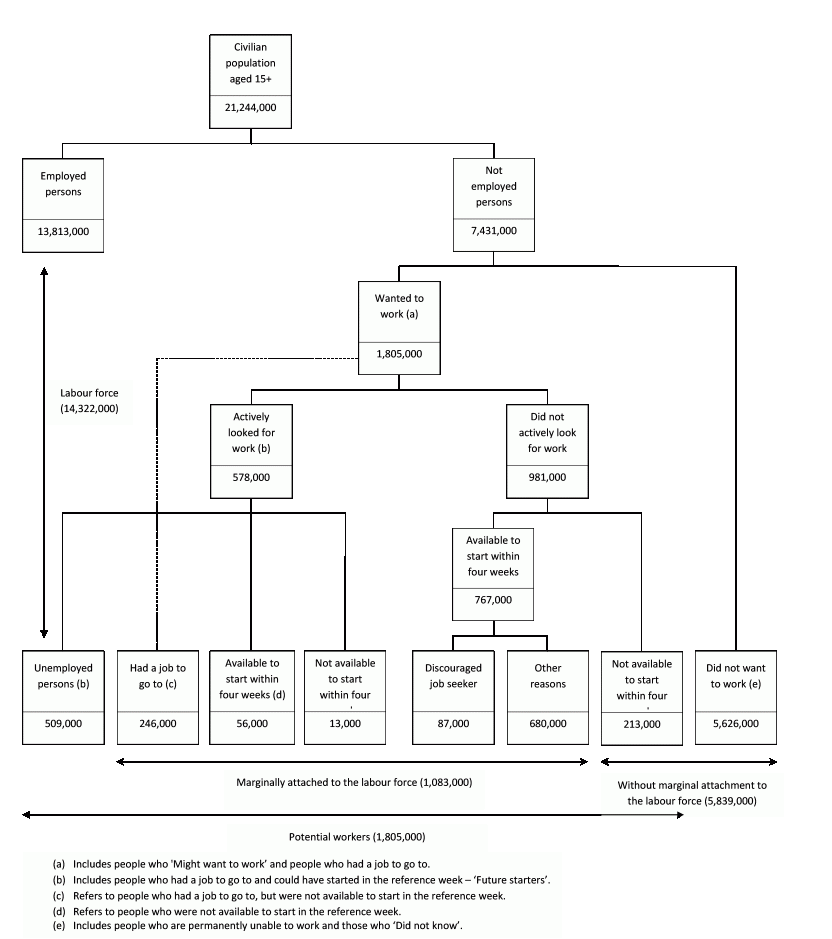Chart 3: Potential workers
[["Feb-15","Mar-15","Apr-15","May-15","Jun-15","Jul-15","Aug-15","Sep-15","Oct-15","Nov-15","Dec-15","Jan-16","Feb-16","Mar-16","Apr-16","May-16","Jun-16","Jul-16","Aug-16","Sep-16","Oct-16","Nov-16","Dec-16","Jan-17","Feb-17","Mar-17","Apr-17","May-17","Jun-17","Jul-17","Aug-17","Sep-17","Oct-17","Nov-17","Dec-17","Jan-18","Feb-18","Mar-18","Apr-18","May-18","Jun-18","Jul-18","Aug-18","Sep-18","Oct-18","Nov-18","Dec-18","Jan-19","Feb-19","Mar-19","Apr-19","May-19","Jun-19","Jul-19","Aug-19","Sep-19","Oct-19","Nov-19","Dec-19","Jan-20","Feb-20","Mar-20","Apr-20","May-20","Jun-20","Jul-20","Aug-20","Sep-20","Oct-20","Nov-20","Dec-20","Jan-21","Feb-21","Mar-21","Apr-21","May-21","Jun-21","Jul-21","Aug-21","Sep-21","Oct-21","Nov-21","Dec-21","Jan-22","Feb-22","Mar-22","Apr-22","May-22","Jun-22","Jul-22","Aug-22","Sep-22","Oct-22","Nov-22","Dec-22","Jan-23","Feb-23"],[[97.599999999999994],[null],[null],[null],[null],[null],[null],[null],[null],[null],[null],[null],[100.90000000000001],[null],[null],[null],[null],[null],[null],[null],[null],[null],[null],[null],[96.400000000000006],[null],[null],[null],[null],[null],[null],[null],[null],[null],[null],[null],[96.799999999999997],[null],[null],[null],[null],[null],[null],[null],[null],[null],[null],[null],[111.2],[null],[null],[null],[null],[null],[null],[null],[null],[null],[null],[null],[109.7],[null],[null],[null],[null],[null],[null],[null],[null],[null],[null],[null],[120.5],[null],[null],[null],[null],[null],[null],[null],[null],[null],[null],[null],[118.09999999999999],[null],[null],[null],[null],[null],[null],[null],[null],[null],[null],[null],[109.90000000000001]],[[265.60000000000002],[null],[null],[null],[null],[null],[null],[null],[null],[null],[null],[null],[263.19999999999999],[null],[null],[null],[null],[null],[null],[null],[null],[null],[null],[null],[291.19999999999999],[null],[null],[null],[null],[null],[null],[null],[null],[null],[null],[null],[283.19999999999999],[null],[null],[null],[null],[null],[null],[null],[null],[null],[null],[null],[305.10000000000002],[null],[null],[null],[null],[null],[null],[null],[null],[null],[null],[null],[328.10000000000002],[null],[null],[null],[null],[null],[null],[null],[null],[null],[null],[null],[340.5],[null],[null],[null],[null],[null],[null],[null],[null],[null],[null],[null],[367.69999999999999],[null],[null],[null],[null],[null],[null],[null],[null],[null],[null],[null],[356.39999999999998]],[[717.10000000000002],[null],[null],[null],[null],[null],[null],[null],[null],[null],[null],[null],[681],[null],[null],[null],[null],[null],[null],[null],[null],[null],[null],[null],[695],[null],[null],[null],[null],[null],[null],[null],[null],[null],[null],[null],[679.70000000000005],[null],[null],[null],[null],[null],[null],[null],[null],[null],[null],[null],[634.10000000000002],[null],[null],[null],[null],[null],[null],[null],[null],[null],[null],[null],[650],[null],[null],[null],[null],[null],[null],[null],[null],[null],[null],[null],[766.79999999999995],[null],[null],[null],[null],[null],[null],[null],[null],[null],[null],[null],[501.60000000000002],[null],[null],[null],[null],[null],[null],[null],[null],[null],[null],[null],[467.80000000000001]],[[1299.9000000000001],[null],[null],[null],[null],[null],[null],[null],[null],[null],[null],[null],[1231.9000000000001],[null],[null],[null],[null],[null],[null],[null],[null],[null],[null],[null],[1260.9000000000001],[null],[null],[null],[null],[null],[null],[null],[null],[null],[null],[null],[1233.8],[null],[null],[null],[null],[null],[null],[null],[null],[null],[null],[null],[1143.7],[null],[null],[null],[null],[null],[null],[null],[null],[null],[null],[null],[1144.4000000000001],[null],[null],[null],[null],[null],[null],[null],[null],[null],[null],[null],[1239.8],[null],[null],[null],[null],[null],[null],[null],[null],[null],[null],[null],[906.79999999999995],[null],[null],[null],[null],[null],[null],[null],[null],[null],[null],[null],[882.10000000000002]],[[1629.4000000000001],[null],[null],[null],[null],[null],[null],[null],[null],[null],[null],[null],[1558.7],[null],[null],[null],[null],[null],[null],[null],[null],[null],[null],[null],[1572.8],[null],[null],[null],[null],[null],[null],[null],[null],[null],[null],[null],[1554.2],[null],[null],[null],[null],[null],[null],[null],[null],[null],[null],[null],[1472.4000000000001],[null],[null],[null],[null],[null],[null],[null],[null],[null],[null],[null],[1517.0999999999999],[null],[null],[null],[null],[null],[null],[null],[null],[null],[null],[null],[1606.5],[null],[null],[null],[null],[null],[null],[null],[null],[null],[null],[null],[1241],[null],[null],[null],[null],[null],[null],[null],[null],[null],[null],[null],[1222.0999999999999]],[[1859],[null],[null],[null],[null],[null],[null],[null],[null],[null],[null],[null],[1796],[null],[null],[null],[null],[null],[null],[null],[null],[null],[null],[null],[1791.5999999999999],[null],[null],[null],[null],[null],[null],[null],[null],[null],[null],[null],[1797.4000000000001],[null],[null],[null],[null],[null],[null],[null],[null],[null],[null],[null],[1686.5999999999999],[null],[null],[null],[null],[null],[null],[null],[null],[null],[null],[null],[1745],[null],[null],[null],[null],[null],[null],[null],[null],[null],[null],[null],[1842.3],[null],[null],[null],[null],[null],[null],[null],[null],[null],[null],[null],[1449.5],[null],[null],[null],[null],[null],[null],[null],[null],[null],[null],[null],[1448.3]],[[2124.5999999999999],[null],[null],[null],[null],[null],[null],[null],[null],[null],[null],[null],[2059.1999999999998],[null],[null],[null],[null],[null],[null],[null],[null],[null],[null],[null],[2082.8000000000002],[null],[null],[null],[null],[null],[null],[null],[null],[null],[null],[null],[2080.5999999999999],[null],[null],[null],[null],[null],[null],[null],[null],[null],[null],[null],[1991.7],[null],[null],[null],[null],[null],[null],[null],[null],[null],[null],[null],[2073.0999999999999],[null],[null],[null],[null],[null],[null],[null],[null],[null],[null],[null],[2182.8000000000002],[null],[null],[null],[null],[null],[null],[null],[null],[null],[null],[null],[1817.0999999999999],[null],[null],[null],[null],[null],[null],[null],[null],[null],[null],[null],[1804.7]],[[203.69999999999999],[151.30000000000001],[163.40000000000001],[147.5],[139],[154],[177.30000000000001],[168.59999999999999],[172.80000000000001],[169.5],[173.09999999999999],[301.5],[190.59999999999999],[165.19999999999999],[154.40000000000001],[164.09999999999999],[157.09999999999999],[179.09999999999999],[186.80000000000001],[172.90000000000001],[179.5],[185.09999999999999],[187.90000000000001],[311.10000000000002],[218.40000000000001],[178.90000000000001],[170.69999999999999],[167.59999999999999],[168.80000000000001],[191.90000000000001],[180.59999999999999],[153.80000000000001],[174.59999999999999],[165.5],[174.40000000000001],[282.89999999999998],[194.90000000000001],[170.5],[163.69999999999999],[161.30000000000001],[163.59999999999999],[178.19999999999999],[188.59999999999999],[168.19999999999999],[174.69999999999999],[191.69999999999999],[182.40000000000001],[316.39999999999998],[203.19999999999999],[191.80000000000001],[179.90000000000001],[176.40000000000001],[186.30000000000001],[185.30000000000001],[175.80000000000001],[182.80000000000001],[196.90000000000001],[215.40000000000001],[208.69999999999999],[332.60000000000002],[240.40000000000001],[188.90000000000001],[313.39999999999998],[589.5],[437.30000000000001],[360.80000000000001],[298.30000000000001],[303.39999999999998],[287.89999999999998],[256.19999999999999],[214.30000000000001],[356.19999999999999],[247.59999999999999],[180.09999999999999],[202.30000000000001],[191.19999999999999],[215.90000000000001],[245.30000000000001],[377],[522.39999999999998],[526.79999999999995],[278],[248.19999999999999],[402.5],[266.80000000000001],[232.09999999999999],[233.5],[221.19999999999999],[213.30000000000001],[232.30000000000001],[232.90000000000001],[205.80000000000001],[227.80000000000001],[211.09999999999999],[234.30000000000001],[412.89999999999998],[265.80000000000001]],[[764.89999999999998],[759.39999999999998],[760.29999999999995],[739.20000000000005],[749.89999999999998],[788.60000000000002],[763.89999999999998],[774.5],[746.70000000000005],[740.10000000000002],[725.39999999999998],[763.79999999999995],[719.70000000000005],[714.70000000000005],[713.89999999999998],[724.10000000000002],[723.10000000000002],[725.60000000000002],[712.5],[716.29999999999995],[709.70000000000005],[734.89999999999998],[745.39999999999998],[727],[748.79999999999995],[752.39999999999998],[723],[714.79999999999995],[726.10000000000002],[727.79999999999995],[720],[712.79999999999995],[702.29999999999995],[711.89999999999998],[739.89999999999998],[727.70000000000005],[735.5],[728],[732.20000000000005],[712.39999999999998],[708.70000000000005],[704],[704.20000000000005],[669.10000000000002],[668.39999999999998],[684.10000000000002],[672.20000000000005],[677.70000000000005],[666.39999999999998],[683.39999999999998],[704.29999999999995],[705.10000000000002],[714.5],[718.89999999999998],[720],[712.20000000000005],[724],[704.70000000000005],[691.60000000000002],[721.29999999999995],[695.29999999999995],[712.89999999999998],[834.89999999999998],[912.89999999999998],[993.39999999999998],[1015.8],[925.10000000000002],[936.79999999999995],[955.20000000000005],[940],[906.39999999999998],[870.5],[797.70000000000005],[774.39999999999998],[744.39999999999998],[697.60000000000002],[687.60000000000002],[649.10000000000002],[622.29999999999995],[630.79999999999995],[711.60000000000002],[637.10000000000002],[578.89999999999998],[578.20000000000005],[560.60000000000002],[549],[543.5],[551.39999999999998],[506.30000000000001],[488.39999999999998],[498.19999999999999],[507.30000000000001],[487.80000000000001],[495.60000000000002],[503.89999999999998],[525.20000000000005],[510.30000000000001]]]
[]
[{"axis_id":"0","tick_interval":"","axis_min":"","axis_max":"","axis_title":"","precision":-1,"axis_units":"","tooltip_units":"","table_units":"","data_unit_prefix":"","data_unit_suffix":"","reverse_axis":false}][{"value":"0","axis_id":"0","axis_title":"Potential workers ('000)","axis_units":"","tooltip_units":"('000)","table_units":"('000)","axis_min":"0","axis_max":"2500","tick_interval":null,"precision":"1","data_unit_prefix":"","data_unit_suffix":"","reverse_axis":false}]